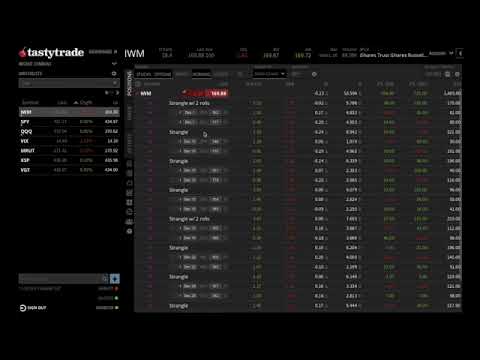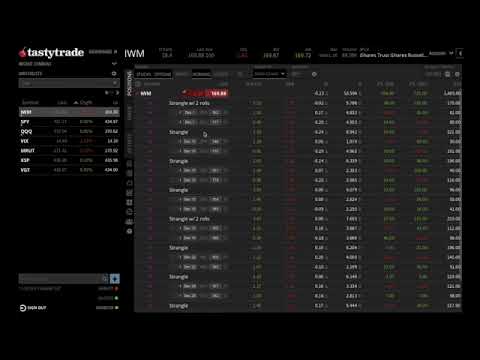In this video, we’ll explore how to monitor your positions on a daily basis. If you can spare 15 to 30 minutes each day, logging into your trading platform, this is what you need to know. First, locate the tab that displays all your positions, which will vary depending on the broker you use. The focus should be on monitoring UI version 1 and version 2 strategies, as well as defensive income strategies. Pay closer attention to in-the-money positions, while out-of-the-money positions can be left alone. The video provides a demonstration of position monitoring using the Tasty Trade platform and gives an example of a Jade Lizard strategy that has no risk to the upside. It also briefly covers how to roll positions using the Tasty Trade platform, with the decision to roll depending on chart analysis and market conditions. Monitoring positions daily is a quick task that requires attention to in-the-money positions.
In this video, we’ll show you how to monitor your positions daily in just 15 to 30 minutes. Start by accessing the tab where all your positions are displayed, which may vary depending on your broker. It’s important to focus on monitoring UI version 1 and version 2 strategies, as well as defensive income strategies. Keep a closer eye on in-the-money positions, but out-of-the-money positions can generally be left alone. The video showcases monitoring positions on the Tasty Trade platform, using a Jade Lizard strategy as an example, which carries no risk to the upside. Additionally, it briefly explains how to roll positions using the Tasty Trade platform, with chart analysis and market conditions guiding the decision. Monitoring your positions daily is a quick and easy task, with the main focus on in-the-money positions.
Overview of Daily Position Monitoring
1.1 Importance of daily position monitoring
Daily position monitoring is crucial for successful trading. By regularly checking your positions, you can assess their performance, identify any potential risks or opportunities, and make informed decisions about managing them. It allows you to stay on top of market trends and react accordingly to protect your investments and maximize your profits.
1.2 Time commitment required
Monitoring your positions daily requires a commitment of about 15 to 30 minutes each day. This time investment is essential to stay updated and make timely adjustments to your trades. By dedicating a small portion of your day to monitoring, you can proactively manage your positions and mitigate any potential losses or missed opportunities.
1.3 Focus on different types of strategies
When monitoring your positions, it is important to focus on different types of strategies. This includes UI versions 1 and 2 strategies, as well as defensive income strategies. Each strategy requires a specific approach to monitoring and management. By understanding the nuances of each strategy, you can effectively evaluate their performance and make appropriate adjustments when necessary.
2. Accessing Your Positions
2.1 Logging into your trading platform
To begin monitoring your positions, the first step is to log into your trading platform. Depending on the broker you use, the login process may vary. Whether you’re using Tasty Trade, Interactive Brokers, TD Ameritrade, Fidelity, Robinhood, or any other platform, you need to access the platform where you can view all your positions in one place.
2.2 Navigating to the positions tab
Once you’ve logged into your trading platform, navigate to the tab or section where you can see all your positions. This may be labeled as “Positions” or something similar. It is important to locate this section as it will be the primary area where you monitor and manage your trades.
2.3 Understanding position details
Within the positions tab, you will find detailed information about each of your positions. This includes the ticker symbol, quantity, entry price, current price, and other relevant data. Understanding these position details is crucial for evaluating their performance and making informed decisions about adjustments or exits.
3. Monitoring Strategies in UI Version 1
3.1 Understanding UI Version 1 strategies
UI Version 1 strategies are a type of options trading strategy that focuses on generating income from selling options premiums. When monitoring UI Version 1 strategies, you need to assess the performance of each trade and evaluate if adjustments are necessary based on market conditions and risk management.
3.2 Identifying in-the-money positions
In-the-money positions refer to trades where the underlying security or index price is above the strike price for call options or below the strike price for put options. These positions require closer attention as they may require adjustments to manage risk or capture potential profits.
3.3 Managing out-of-the-money positions
Out-of-the-money positions are trades where the underlying security or index price is below the strike price for call options or above the strike price for put options. These positions generally do not require immediate adjustments unless market conditions or other factors indicate a need for risk management. It is important to assess the need for adjustments on a case-by-case basis.
4. Monitoring Strategies in UI Version 2
4.1 Exploring UI Version 2 strategies
UI Version 2 strategies are another type of options trading strategy that focuses on generating income from selling options premiums. This strategy differs from UI Version 1 in terms of risk and profit potential. When monitoring UI Version 2 strategies, it is important to evaluate their performance and assess if adjustments are necessary based on market conditions and risk management.
4.2 Strategies with no risk to the upside
Some UI Version 2 strategies, such as the Jade Lizard, have no risk to the upside. This means that even if the market moves beyond the call spread, the trade remains profitable. When monitoring these strategies, it is essential to ensure that the trade is still within the desired parameters and adjust if necessary.
4.3 Evaluating profit potential
Monitoring the profit potential of UI Version 2 strategies is crucial for capitalizing on income-generating opportunities. By assessing the probability of profit and analyzing the risk-reward ratio, you can make informed decisions about managing your positions and potentially increasing your profits.
5. Monitoring Defensive Income Strategies

5.1 Importance of monitoring defensive income strategies
Defensive income strategies, such as the put ratio spread and put broken-wing butterfly, provide a more conservative approach to options trading. Monitoring these strategies is important to ensure they remain within desired risk parameters and adjust if necessary to manage potential downside risks.
5.2 Identifying potential areas of risk
When monitoring defensive income strategies, it is crucial to identify any potential areas of risk. This includes evaluating the underlying security or index price relative to the strike prices of the options involved in the strategy. By identifying potential risk areas, you can take appropriate action to manage and mitigate potential losses.
5.3 Adjusting positions to manage risk
If you identify potential areas of risk within your defensive income strategies, it may be necessary to adjust your positions to manage that risk. This can involve rolling options, adjusting strike prices, or implementing other risk mitigation strategies. Regular monitoring enables you to take proactive steps to protect your investments.
6. Focus on In-The-Money Positions
6.1 Significance of in-the-money positions
In-the-money positions require closer attention due to their increased risk and potential for loss. It is important to regularly monitor these positions to assess their performance and determine if adjustments are necessary to manage risk or capture potential profits.
6.2 Evaluating risk and potential loss
When monitoring in-the-money positions, it is essential to evaluate the risk and potential loss associated with the trade. This includes assessing factors such as the underlying security’s price movement, expiration date, and the options’ strike prices. By understanding the potential risks, you can make informed decisions about managing these positions effectively.
6.3 Making informed decisions for in-the-money positions
Regular monitoring of in-the-money positions allows you to make informed decisions based on the changing market conditions and the position’s performance. These decisions may involve adjusting strike prices, rolling options, or closing positions to manage risk or capture profits. A proactive and well-informed approach is crucial for successful management of in-the-money positions.
7. Managing Out-of-The-Money Positions
7.1 Understanding out-of-the-money positions
Out-of-the-money positions have a lower risk profile compared to in-the-money positions. These trades are where the underlying security or index price is not favorable for the options’ strike prices. Monitoring out-of-the-money positions is important to assess if adjustments or exits are necessary based on market conditions and risk management.
7.2 Assessing the need for adjustments
When monitoring out-of-the-money positions, it is essential to assess if any adjustments are necessary. This includes considering factors such as market trends, the probabilities of profit, and the expiration date of the options. Adjustments may be required to optimize potential profits or manage potential risks.
7.3 When to leave out-of-the-money positions untouched
In some cases, out-of-the-money positions may not require immediate adjustments. This may be due to favorable market conditions, low risk exposure, or the trade remaining within desired parameters. It is important to evaluate each out-of-the-money position individually and determine if intervention is necessary based on the specific circumstances.
8. Monitoring Positions Using Tasty Trade
8.1 Overview of the Tasty Trade platform
Tasty Trade is a trading platform that provides tools and resources for monitoring and managing positions. It offers a user-friendly interface and various features that allow traders to stay updated on their positions, evaluate performance, and make informed decisions.
8.2 Demonstrating position monitoring in Tasty Trade
When using Tasty Trade to monitor positions, you can easily access the positions tab to view all your trades in one place. In this section, you can analyze the performance of each trade and identify any in-the-money or out-of-the-money positions that require attention or potential adjustments.
8.3 Utilizing the platform’s features for effective monitoring
Tasty Trade offers various features to enhance the monitoring and management of positions. These features include chart analysis tools, options chain functionality, and order entry capabilities. By utilizing these features, you can gain valuable insights into your positions and make more informed decisions about adjustments or exits.
9. Deciding Whether to Roll a Position
9.1 Factors influencing the decision to roll a position
The decision to roll a position involves considering various factors, such as market conditions, chart analysis, and risk management. Factors like potential profit, expiration date, and the underlying security’s price movement play a significant role in determining whether rolling a position is necessary or beneficial.
9.2 Importance of chart analysis
Chart analysis is an essential tool for evaluating the performance and potential of a position. By analyzing price patterns, support and resistance levels, and other technical indicators, you can gain insights into the market’s direction and make informed decisions about rolling a position.
9.3 Considering market conditions
Market conditions, such as volatility, overall trend, and economic factors, have a significant impact on the decision to roll a position. It is important to assess the current market environment and determine if rolling a position is appropriate based on the potential risks and opportunities presented.
11. Conclusion
Monitoring your positions daily is a crucial aspect of successful trading. By dedicating a small portion of your day to regularly assess your positions, you can identify potential risks, evaluate performance, and make informed decisions about adjustments or exits. Utilizing the features of your trading platform, such as chart analysis tools and options chain functionality, enhances your ability to effectively monitor and manage your trades. With a proactive and well-informed approach, you can protect your investments, optimize profits, and navigate the dynamic world of trading with confidence.
